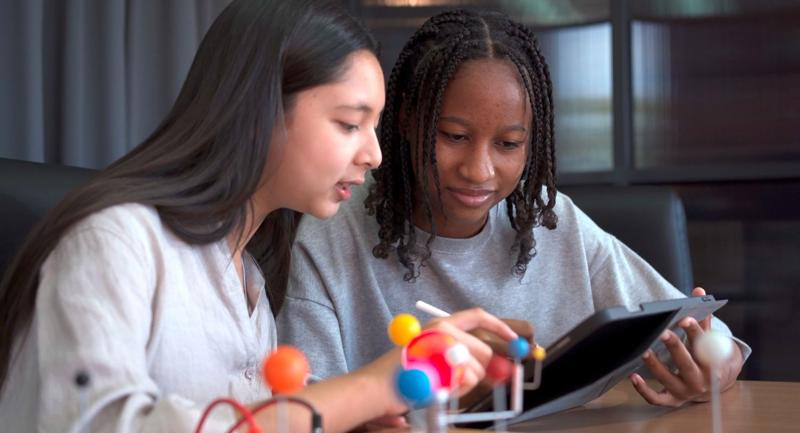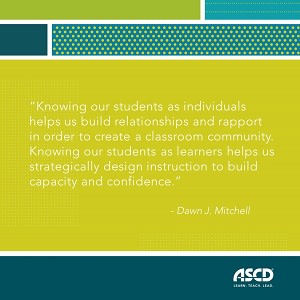As teachers get used to the routine of onboarding new students year after year, it’s easy to forget what it was like when we first stepped into a new classroom. But if you let your mind drift back, you may remember the feeling of butterflies—or rocks—in your stomach. Multilingual learners (MLLs) who step into a new class full of native English speakers often experience the same wave of emotions: excitement, inadequacy, anticipation, possibility, and, of course, anxiety. They also have the added challenges of adjusting to a new culture, learning new rules and expectations, and acquiring the language skills to allow them to keep up.
Some schools can support MLLs using sheltered instruction or in English language development classes, but implementation can be tricky. Luckily there are small steps we can take to make them feel not only welcome and invited, but a part of the class. Helping students feel like they are not just participating but integrated into the classroom culture can help them settle in, find friends, and move toward a joyful experience at school.
Helping students feel like they are not just participating but integrated into the classroom culture can help them settle in, find friends, and move toward a joyful experience at school.
Many teachers have great techniques for building excellent classroom culture, and usually it only takes a few tweaks to make sure that you’re being inclusive and sensitive to the different needs of your MLLs. Let’s look at a few ways you can help support all students at once.
Breaking the Ice
Most teachers concerned with building positive classroom culture will offer an icebreaker at the beginning of the class so students can get to know one another. Traditional activities like “Find Someone Who…”, where students walk around the room looking for people who fit categories laid out on a BINGO card, are easy to adjust to include students who might need a little extra attention. I’d encourage you to add one or two categories that can specifically highlight your multilingual learners’ experiences, such as, “Find someone who speaks another language” or “Find someone who has traveled the furthest.” This sends a subtle message to other students in the class that the assets MLLs have are positive and something they can contribute to the class. Be careful not to overemphasize the fact that they’re from another country or culture—treat it as a bonus. The goal is to make everybody feel like they’re part of the same team, not to exoticize anyone.
Another popular classroom icebreaker is charades. Some teachers might think it’s fun to bring in modern cultural references, but that might leave out students who are new to the culture. Instead, when choosing your keywords, keep it focused on simple vocabulary that you’re confident the whole class can understand. “Bear” can be just as fun as “Rick Roll” without needing to know about meme culture or 80s pop music. If a student doesn’t recognize a word or term they’re meant to act out, it can also help to show a picture to make sure they understand. It’s very likely that all your students know who Iron Man is, but he might have a different name in different countries. Quickly finding a photo on your phone for your student can confirm their understanding and make sure they’re ready to play along.
The Surprising Survey
One of my favorite tricks in my own class is to use information about students’ personal preferences or interests in ways that they don’t expect. On a Google Form at the beginning of the year, I send out a “getting to know you” survey, including a few questions like, “Who is your favorite athlete?”, “What social media influencer do you like to watch?”, and “Link me to your favorite song on YouTube.” As the semester goes on, most students quickly forget that they even filled it out. A few weeks later when I start incorporating their favorite content into class, they feel a sense of connection that I might not have gotten any other way.
For example, I populate students’ favorite athletes, actors or actresses, and other celebrities in my quiz questions, word problems, etc. Social media influencers, assuming they’re classroom-appropriate, are gold mines for content that are relevant to students. You don’t have to spend all your time watching their content, but if a video is relevant to your lesson plan, you can assign it for students to watch.
Your MLLs will also hear their own music as a regular part of the classroom soundscape, allowing music to be a great source of connection.
But above all, my favorite way to use this information is to build a class playlist with the songs they share with me. I play them quietly on the speakers before class and during breaktime. Sooner or later a student will inevitably say, “How do you know this song?” without recognizing that they’re the one who shared it with me. Your MLLs will also hear their own music as a regular part of the classroom soundscape, allowing music to be a great source of connection.
AI to Gloss the Pain Points
While conversations around AI have been fraught, there’s no arguing that it’s incredible at working with text at a level we’ve never experienced before. One of the greatest uses for generative AI is customizing content to your students' needs. Your students may be fully capable of doing well in a biology class in their home country but struggle to follow along with the complex concepts and vocabulary when it’s presented to them in English. An AI chatbot like ChatGPT or Microsoft Copilot can do a great job of translating text directly for your students, but to truly bring them to the same level as the rest of their classmates, a better option may be to give them the same text, customized to their needs.
We can use chatbots to gloss texts for our students so they’re working with the same content as everybody else, just with some adjustments to ensure equitable understanding.
In language education, the term “glossing” refers to the practice of defining overwrought vocabulary (difficult words) directly in the text to help students understand the words or concepts without having to deal with distractions from having to look up the definitions of words. We can use chatbots to gloss texts for our students so they’re working with the same content as everybody else, just with some adjustments to ensure equitable understanding. You can play with different prompts to use in a chatbot, but a couple of simple options might look like this:
I am attaching a text for my Concepts of Biology science class. Please gloss the content for an English Language Learner in my class by defining any tricky vocabulary words in parentheses.
If a student needs more help, you can customize the prompt. Test out different languages and parameters to help get closer to your students’ needs. If we imagine the scenario above where a high school student did very well in their biology classes in high school in South America, but they find themselves struggling even with the glossed materials, you can include Spanish explanations:
I am attaching a text for my Concepts of Biology science class. One of my students excels in her science classes in Venezuela, but she’s struggling to understand the English texts. Please use Spanish where appropriate to gloss the content for this student.
A chatbot can complete this task in a matter of seconds, and a moment of your time can bring a lifetime of relief to your student. They will feel understood and respected, recognizing that it’s not the content but the language that may be causing their struggle. When students feel respected and understood, it’s amazing how much more effort they’ll put into living up to the expectations of their teacher and classmates.
Feeling Included
As the old saying goes, “An ounce of prevention is worth a pound of cure.” The suggestions above are not complicated, but they do require a small shift in thinking about how you’re preparing your classes. Mixing a little technology with a little mindfulness can go a long way to lowering stress, building relationships, and bringing a sense of relief and joy to the learning process for students who are too often overlooked. What are the small changes you can make that can create a stellar experience for not just some, but all students in your class?
Editor's Note: A version of this blog appeared in EL magazine.








